Land-Use Transformation and Its Eco-Environmental Effects of Production–Living–Ecological Space Based on the County Level in the Yellow River Basin
Abstract
1. Introduction
2. Materials and Methods
2.1. Study Area
2.2. Data Sources and Preprocessing
2.3. Land-Use Transition Mode
2.4. Eco-Environment Effects
2.5. Driving Factors Detection Based on Random Forest
3. Results
3.1. Land-Use Structure from the Perspective of PLES on the County Level
3.2. The Transition Mode Based on the County Level
3.3. Eco-Environmental Quality
3.4. Driving Factors for PLES Evolution
4. Discussions
4.1. The Influencing Factors for PLES and EQI Evolution Patterns
4.2. Uncertainties in EQI Assessment
5. Conclusions
Author Contributions
Funding
Data Availability Statement
Conflicts of Interest
References
- Winkler, K.; Fuchs, R.; Rounsevell, M.; Herold, M. Global land use changes are four times greater than previously estimated. Nat. Commun. 2021, 12, 2501. [Google Scholar] [CrossRef] [PubMed]
- Hanaõcek, K.; Rodríguez-Labajos, B. Impacts of land-use and management changes on cultural agroecosystem services and environmental conflicts-a global review. Glob. Environ. Change 2018, 50, 41–59. [Google Scholar] [CrossRef]
- Lambin, E.F.; Meyfroidt, P. Global land use change, economic globalization, and the looming land scarcity. Proc. Natl. Acad. Sci. USA 2011, 108, 3465–3472. [Google Scholar] [CrossRef]
- Tian, F.; Li, M.; Han, X.; Liu, H.; Mo, B. A production–living–ecological space model for land-use optimisation: A case study of the core tumen river region in China. Ecol. Model. 2020, 437, 109310. [Google Scholar] [CrossRef]
- Wang, A.; Liao, X.; Tong, Z.; Du, W.; Zhang, J.; Liu, X.; Liu, M. Spatial-temporal dynamic evaluation of the ecosystem service value from the perspective of “production-living-ecological” spaces: A case study in dongliao River basin, China. J. Clean. Prod. 2022, 333, 130218. [Google Scholar] [CrossRef]
- Jiang, X.T.; Zhai, S.Y.; Liu, H.; Chen, J.; Zhu, Y.Y.; Wang, Z. Multi-scenario simulation of production-living-ecological space and ecological effects based on shared socioeconomic pathways in Zhengzhou, China. Ecol. Indic. 2022, 137, 108750. [Google Scholar] [CrossRef]
- Ning, J.; Liu, J.; Kuang, W.; Xu, X.; Zhang, S.; Yan, C.; Ning, J. Spatiotemporal patterns and characteristics of land-use change in China during 2010–2015. J. Geogr. Sci. 2018, 28, 547–562. [Google Scholar] [CrossRef]
- Fu, B.J.; Tian, H.Q.; Tao, F.L.; Zhao, W.W.; Wang, S. Progress on the impact of global change on ecosystem services. China Basic Sci. 2020, 6, 25–30. (In Chinese) [Google Scholar] [CrossRef]
- Liu, B.; Pan, L.B.; Qi, Y.; Guan, X.; Li, J.S. Land use and land cover change in the Yellow River Basin from 1980 to 2015 and its impact on the ecosystem services. Land 2021, 10, 1080. [Google Scholar] [CrossRef]
- Asabere, S.B.; Acheampong, R.A.; Ashiagbor, G.; Beckers, S.C.; Keck, M.; Erasmi, S.; Schanze, J.; Sauer, D. Urbanization, land use transformation and spatio-environmental impacts: Analyses of trends and implications in major metropolitan regions of Ghana. Land Use Policy 2020, 96, 104707. [Google Scholar] [CrossRef]
- Das, S.; Angadi, D.P. Land use-land cover (LULC) transformation and its relation with land surface temperature changes: A case study of Barrackpore Subdivision, West Bengal, India. Remote Sens. Appl. Soc. Environ. 2020, 19, 100322. [Google Scholar] [CrossRef]
- Nguyen, T.T.; Grote, U.; Neubacher, F.; Rahut, D.B.; Hung, M.; Paudel, G.P. Security risks from climate change and environmental degradation: Implications for sustainable land use transformation in the Global South. Curr. Opin. Environ. Sustain. 2023, 63, 101322. [Google Scholar] [CrossRef]
- Wynn, J.G.; Duvert, C.; Bird, M.I.; Munksgaard, N.C.; Setterfield, S.A.; Hutley, L.B. Land transformation in tropical savannas preferentially decomposes newly added biomass, whether c3 or c4 derived. Ecol. Appl. 2020, 30, e02192. [Google Scholar] [CrossRef] [PubMed]
- Zhao, X.; Calvin, K.V.; Wise, M.A. The critical role of conversion cost and comparative advantage in modeling agricultural land use change. Clim. Change Econ. (CCE) 2020, 11, 1–44. [Google Scholar] [CrossRef]
- Niu, H.P.; Xiu, Z.Y.; Xiao, D.Y. Impact of land-use change on ecological vulnerability in the Yellow River Basin based on a complex network model. Ecol. Indic. 2024, 166, 112212. [Google Scholar] [CrossRef]
- Ofosu, S.A.; Adjei, K.A.; Odai, S. Ecological vulnerability of the Densu river Basin due to land use change and climate variability. Cogent Eng. 2020, 7, 1735714. [Google Scholar] [CrossRef]
- Sun, Z.X.; Liu, Y.; Sang, H.B. Spatial-temporal variation and driving factors of ecological vulnerability in nansi lake basin, China. Int. J. Environ. Res. Public Health 2023, 20, 2653. [Google Scholar] [CrossRef]
- Wang, X.; Ma, J.; Feng, X. Spatio-temporal changes and driving factors of windbreak and sand-fixing services in the ecological security barrier of the Yellow River Basin. Acta Ecol. Sin. 2023, 43, 660–671. [Google Scholar] [CrossRef]
- Li, C.X.; Wu, J.Y. Land use transformation and eco-environmental effects based on production-living-ecological spatial synergy: Evidence from Shaanxi Province, China. Environ. Sci. Pollut. Res. 2022, 29, 41492–41504. [Google Scholar] [CrossRef]
- Li, M.Y.; Li, X.B.; Liu, S.Y.; Lyu, X.; Dang, D.L.; Dou, H.S.; Wang, K.; Cao, W.Y.; Zhang, C.H. Analysis of the spatiotemporal dynamics and driving factors of ecosystem quality in Inner Mongolia from 2005 to 2020. Environ. Technol. Innov. 2024, 35, 103686. [Google Scholar] [CrossRef]
- Xie, X.T.; Li, X.S.; Fan, H.P.; He, W.K. Spatial analysis of production-living-ecological functions and zoning method under symbiosis theory of Henan, China. Environ. Sci. Pollut. Res. 2021, 28, 69093–69110. [Google Scholar] [CrossRef] [PubMed]
- Yousafzai, S.; Saeed, R.; Rahman, G.; Farish, S. Spatio-temporal assessment of land use dynamics and urbanization: Linking with environmental aspects and DPSIR framework approach. Environ. Sci. Pollut. Res. 2022, 29, 81337–81350. [Google Scholar] [CrossRef] [PubMed]
- Fu, J.; Zhang, S. Functional assessment and coordination characteristics of production, living, ecological function—A case study of Henan province, China. Int. J. Environ. Res. Public Health 2021, 18, 8051. [Google Scholar] [CrossRef]
- Wang, D.; Jiang, D.; Fu, J.; Lin, G.; Zhang, J. Comprehensive assessment of production–living–ecological space based on the coupling coordination degree model. Sustainability 2020, 12, 2009. [Google Scholar] [CrossRef]
- Wang, X.; Duan, L.; Zhang, T.; Cheng, W.; Jia, Q.; Li, J.; Li, M.Y. Ecological vulnerability of China’s Yellow River Basin: Evaluation and socioeconomic driving factors. Environ. Sci. Pollut. Res. 2023, 30, 115915–115928. [Google Scholar] [CrossRef]
- Zhang, B.Q.; Tian, L.; Zhao, X.N.; Wu, P.T. Feedbacks between vegetation restoration and local precipitation over the Loess Plateau in China. Sci. China Earth Sci. 2021, 64, 920–931. [Google Scholar] [CrossRef]
- Chen, Y.P.; Fu, B.J.; Zhao, Y.; Wang, K.B.; Zhao, M.M.; Ma, J.F.; Wu, J.H.; Xu, C.; Liu, W.G.; Wang, H. Sustainable development in the Yellow River Basin: Issues and strategies. J. Clean. Prod. 2020, 263, 121223. [Google Scholar] [CrossRef]
- Zhu, M.; Zhang, X.W.; Elahi, E.; Fan, B.B.; Khalid, Z. Assessing ecological product values in the Yellow River Basin: Factors, trends, and strategies for sustainable development. Ecol. Indic. 2024, 160, 111708. [Google Scholar] [CrossRef]
- GB/T 21010-2007; Current Land Use Classification. National Standardization Administration: Beijing, China, 2007.
- Wei, G.E.; Liu, Y.B.; Li, R.Z.; Luo, K.; Liu, C.H. Pattern transformation and spatial heterogeneity mechanism of production-living-ecological spaces in Poyang Lake area in last 40 years. Acta Ecol. Sin. 2024, 44, 2308–2322. (In Chinese) [Google Scholar] [CrossRef]
- Hu, P.; Li, F.; Sun, X.; Liu, Y.; Chen, X.; Hu, D. Assessment of land-use/cover changes and its ecological effect in rapidly urbanized areas—Taking pearl river delta urban agglomeration as a case. Sustainability 2021, 13, 5075. [Google Scholar] [CrossRef]
- Wei, Y.N.; Zhang, Y.; Chen, L.F.; Chen, H.Y.; Zhang, X.Q.; Liu, P. Production–living–ecological space transition and its eco-environmental effects based on an improved area-weighted method: A case study of Gangcheng District, a typical industrial base in China. Front. Environ. Sci. 2022, 10, 972786. [Google Scholar] [CrossRef]
- Liang, X.; Guan, Q.F.; Clarke, K.C.; Liu, S.S.; Wang, B.Y.; Yao, Y. Understanding the drivers of sustainable land expansion using a patch-generating land use simulation (PLUS) model: A case study in Wuhan, China. Comput. Environ. Urban Syst. 2021, 85, 101569. [Google Scholar] [CrossRef]
- Rad, M.R.P.; Toomanian, N.; Khormali, F.; Brungard, C.W.; Komaki, C.B.; Bogaert, P. Updating soil survey maps using random forest and conditioned Latin hypercube sampling in the loess derived soils of northern Iran. Geoderma 2014, 232–234, 97–106. [Google Scholar] [CrossRef]
- Zhang, X.; Zhang, S.C.; Zhang, X.Y.; Liu, J.Y.; Xue, X.F. Spatial and temporal evolution of landscape ecological security and its influencing factors in the Yangtze River Economic Belt from the perspective of production-living-ecological space in the past 40 years. Chin. J. Eco-Agric. 2023, 31, 1539–1552. (In Chinese) [Google Scholar] [CrossRef]
- Fu, B.J.; Wang, S.; Liu, Y.; Liu, J.B.; Liang, W.; Miao, C.Y. Hydrogeomorphic Ecosystem Responses to Natural and Anthropogenic Changes in the Loess Plateau of China. Annu. Rev. Earth Planet. Sci. 2017, 45, 223–243. [Google Scholar] [CrossRef]
- Wu, X.; Wei, Y.; Fu, B.; Wang, S.; Zhao, Y.; Moran, E.F. Evolution and effects of the social-ecological system over a millennium in China’s Loess Plateau. Sci. Adv. 2020, 6, eabc0276. [Google Scholar] [CrossRef]
- Lu, Y.H.; Fu, B.J.; Feng, X.M.; Zeng, Y.; Liu, Y.; Chang, R.Y.; Sun, G.; Wu, B.F. A Policy-Driven Large Scale Ecological Restoration: Quantifying Ecosystem Services Changes in the Loess Plateau of China. PLoS ONE 2012, 7, 31782. [Google Scholar] [CrossRef]
- Dong, J.; Zhang, Z.; Da, X.; Zhang, W.; Feng, X. Eco-environmental effects of land use transformation and its driving forces from the perspective of “production-living-ecological” spaces: A case study of Gansu province. Acta Ecol. Sin. 2021, 41, 5919–5928. [Google Scholar] [CrossRef]
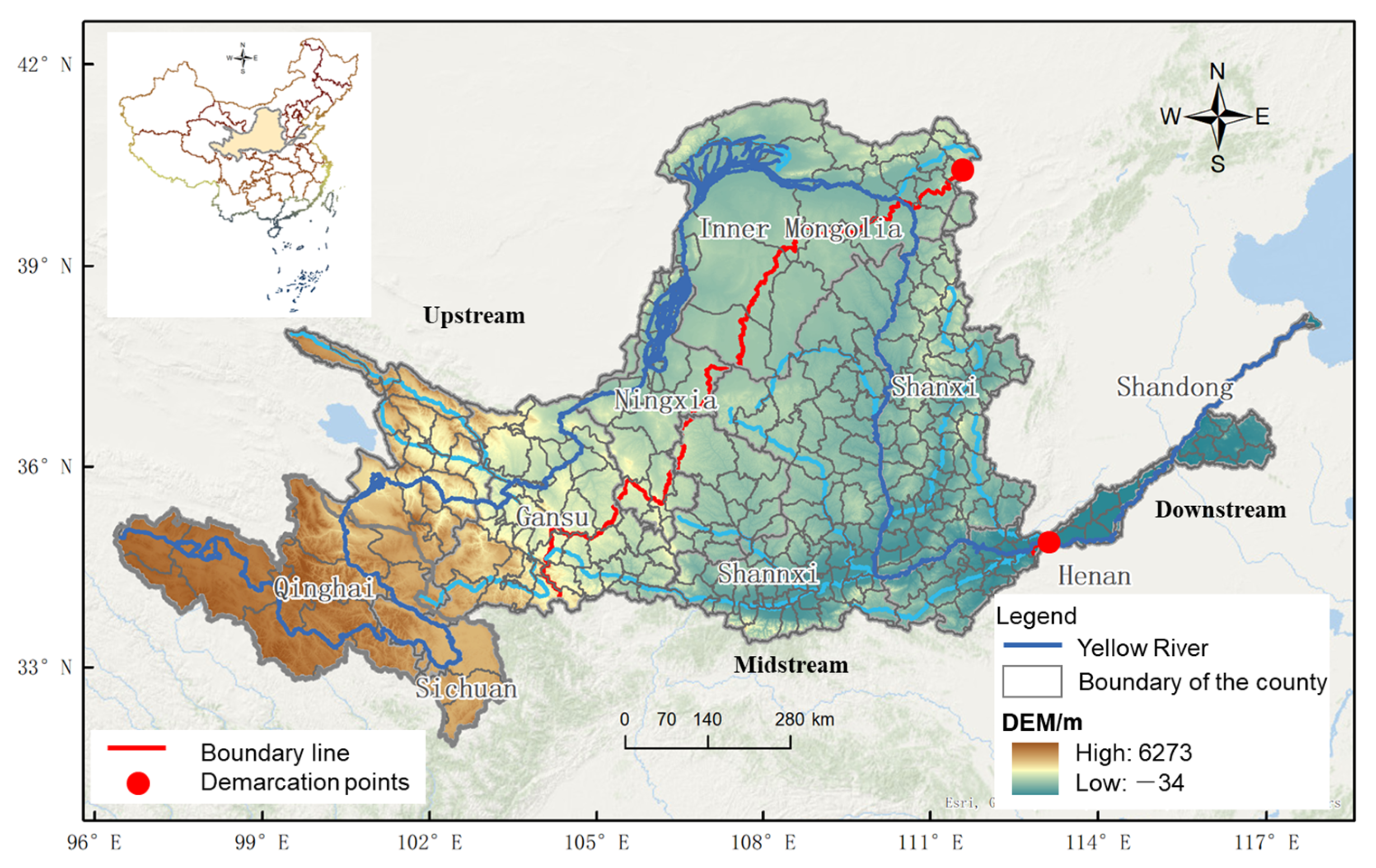
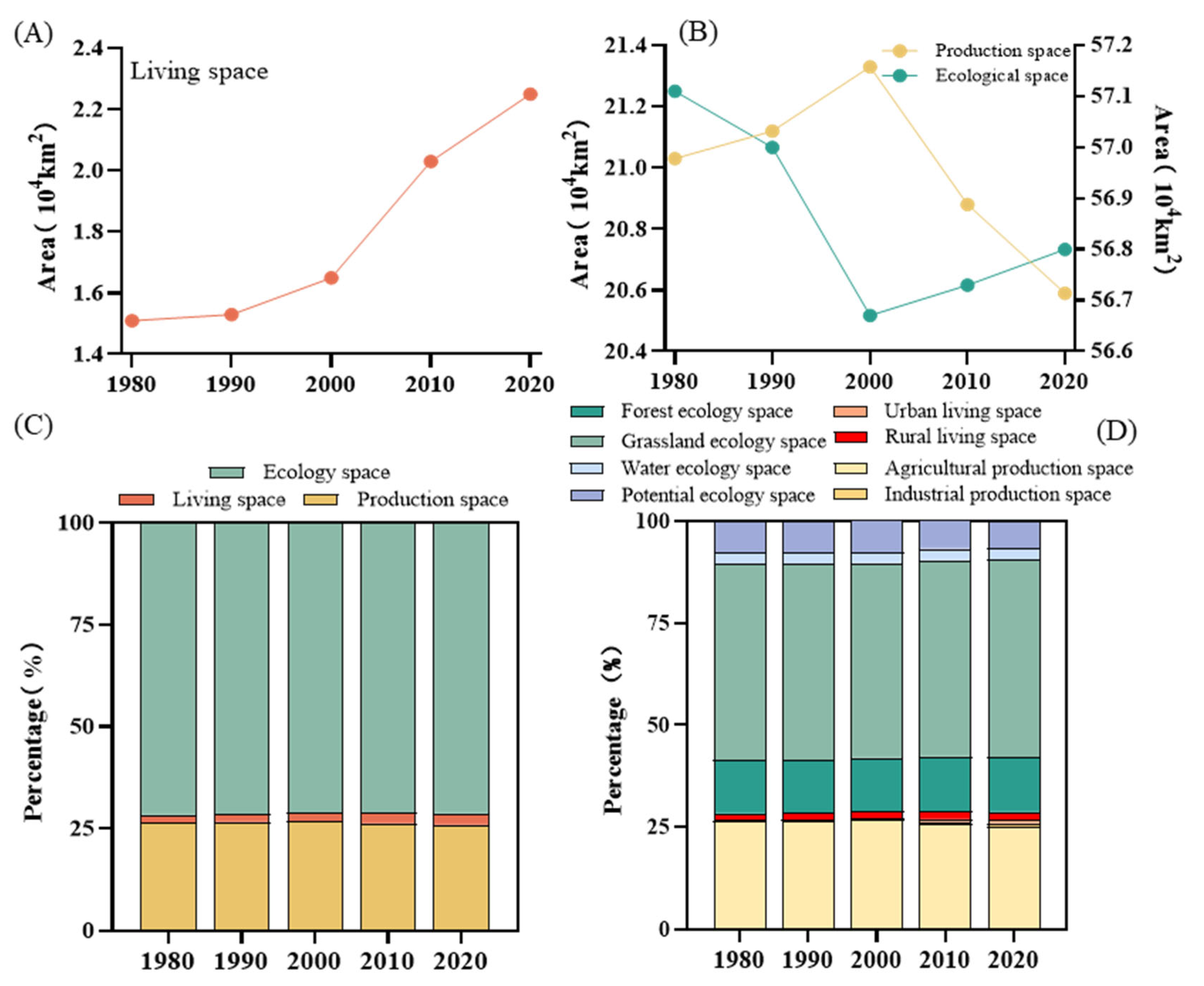
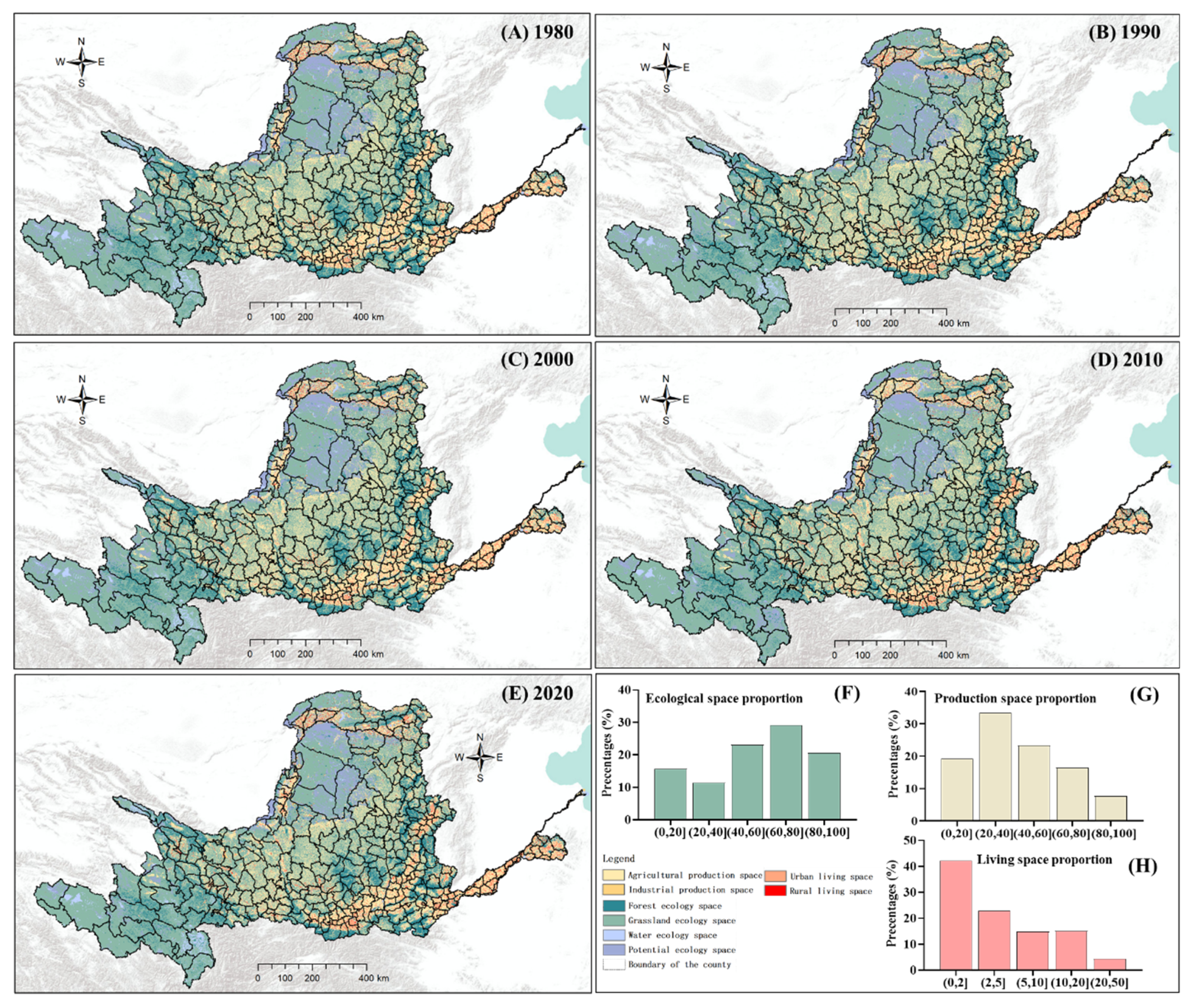
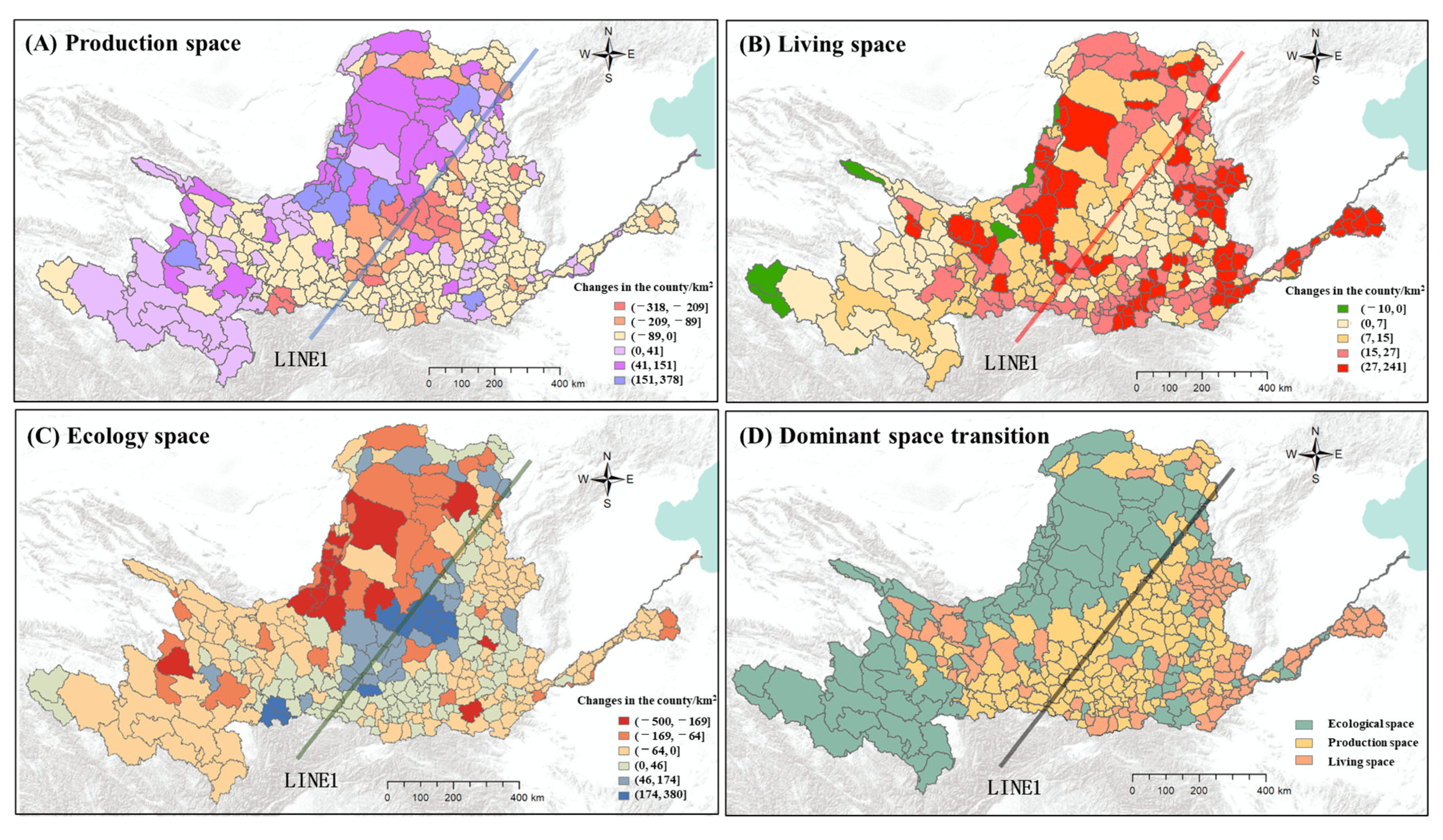
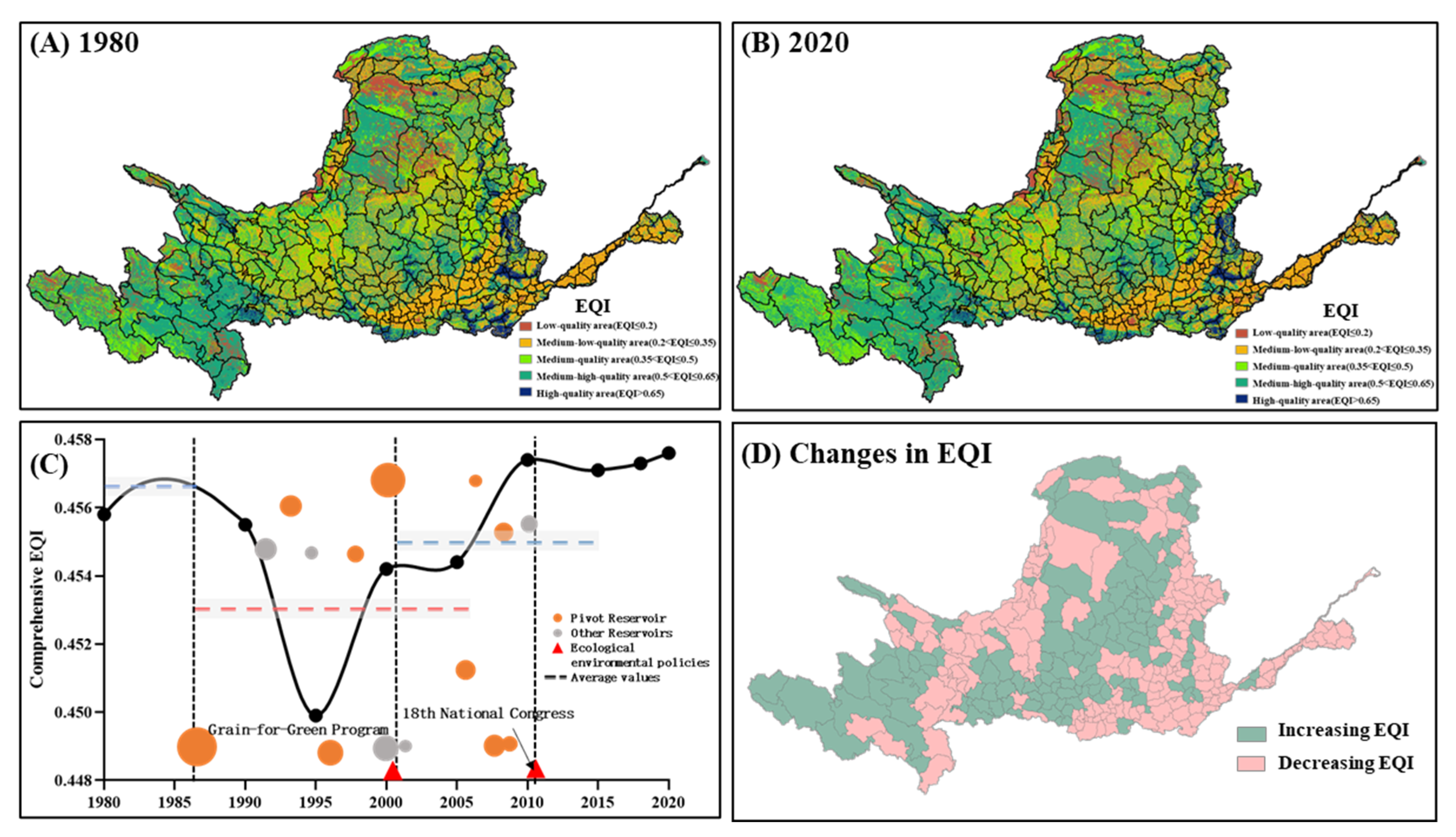
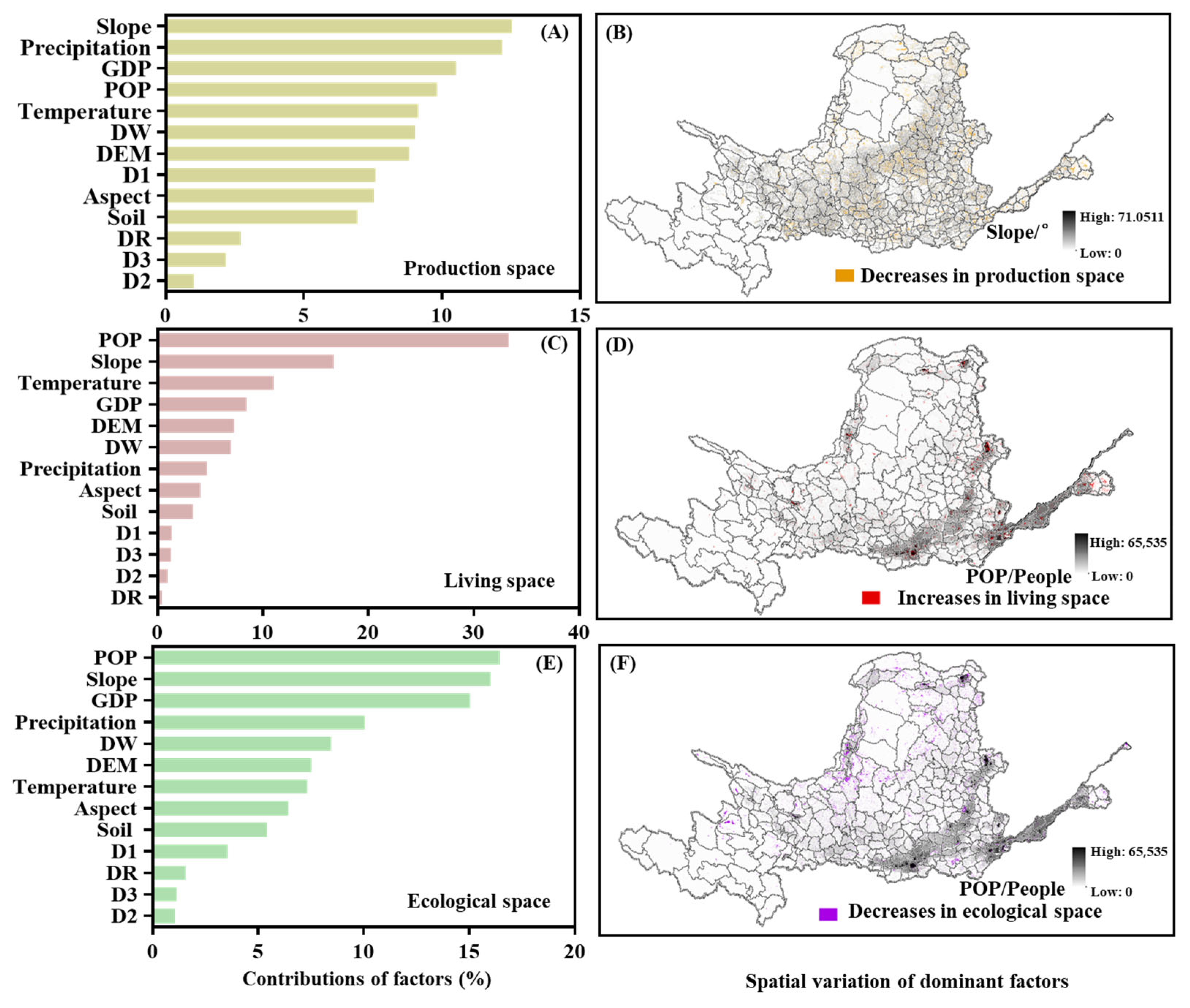
| Primary Land-Use Space | Secondary Land-Use Space | Land-Use Type |
|---|---|---|
| Production space | Agricultural production space | Paddy land (0.30), dry land (0.30) |
| Industrial production space | Mining lease (0.15), transportation land (0.15) | |
| Living space | Urban living space | Urban land (0.20) |
| Rural living space | Rual residential land (0.20) | |
| Ecological space | Forest ecology space | Woodland (0.95), shrubbery (0.65), other woodland (0.50) |
| Grassland ecology space | High-coverage grassland (0.65), middle-coverage grassland (0.55), low-coverage grassland (0.45) | |
| Water ecology space | River (0.53), reservoir pond (0.53), ditches (0.53), inland tidal flats (0.53) | |
| Potential ecology space | Naked land (0.05), sandy land (0.05) |
| Data Type | Data Name | Description |
|---|---|---|
| Natural Factors | DEM | |
| Slope | Calculated from DEM data | |
| Aspect | Calculated from DEM data | |
| Temperature | Interpolated calculation | |
| Precipitation | Interpolated calculation | |
| Distance to water | Euclidean distance | |
| Social Factors | Population | Resampling |
| GDP | Resampling | |
| Distance to class 1 roads | Euclidean distance | |
| Distance to class 2 roads | Euclidean distance | |
| Distance to class 3 roads | Euclidean distance | |
| Distance to railways | Euclidean distance |
| Production–Living–Ecological Land Classification | EQI | ||||||
|---|---|---|---|---|---|---|---|
| Primary Land-Use Space | Secondary Land-Use Space | 1980 | 1990 | 2000 | 2010 | 2020 | Average |
| Production space | Agricultural production space | 0.0789 | 0.0792 | 0.0800 | 0.0775 | 0.0753 | 0.0782 |
| Industrial production space | 0.0001 | 0.0002 | 0.0002 | 0.0006 | 0.0011 | 0.0004 | |
| Living space | Urban living space | 0.0004 | 0.0005 | 0.0006 | 0.0012 | 0.0014 | 0.0008 |
| Rural living space | 0.0033 | 0.0033 | 0.0035 | 0.0039 | 0.0042 | 0.0037 | |
| Ecological space | Forest ecology space | 0.0955 | 0.0956 | 0.0953 | 0.0977 | 0.0973 | 0.0963 |
| Grassland ecology space | 0.2585 | 0.2583 | 0.2568 | 0.2583 | 0.2596 | 0.2583 | |
| Water ecology space | 0.0151 | 0.0145 | 0.0140 | 0.0148 | 0.0154 | 0.0148 | |
| Potential ecology space | 0.0039 | 0.0039 | 0.0039 | 0.0034 | 0.0033 | 0.0037 | |
Disclaimer/Publisher’s Note: The statements, opinions and data contained in all publications are solely those of the individual author(s) and contributor(s) and not of MDPI and/or the editor(s). MDPI and/or the editor(s) disclaim responsibility for any injury to people or property resulting from any ideas, methods, instructions or products referred to in the content. |
© 2025 by the authors. Licensee MDPI, Basel, Switzerland. This article is an open access article distributed under the terms and conditions of the Creative Commons Attribution (CC BY) license (https://creativecommons.org/licenses/by/4.0/).
Share and Cite
Jia, J.; Jiang, E.; Tian, S.; Qu, B.; Li, J.; Hao, L.; Liu, C.; Jing, Y. Land-Use Transformation and Its Eco-Environmental Effects of Production–Living–Ecological Space Based on the County Level in the Yellow River Basin. Land 2025, 14, 427. https://doi.org/10.3390/land14020427
Jia J, Jiang E, Tian S, Qu B, Li J, Hao L, Liu C, Jing Y. Land-Use Transformation and Its Eco-Environmental Effects of Production–Living–Ecological Space Based on the County Level in the Yellow River Basin. Land. 2025; 14(2):427. https://doi.org/10.3390/land14020427
Chicago/Turabian StyleJia, Jia, Enhui Jiang, Shimin Tian, Bo Qu, Jieyu Li, Lingang Hao, Chang Liu, and Yongcai Jing. 2025. "Land-Use Transformation and Its Eco-Environmental Effects of Production–Living–Ecological Space Based on the County Level in the Yellow River Basin" Land 14, no. 2: 427. https://doi.org/10.3390/land14020427
APA StyleJia, J., Jiang, E., Tian, S., Qu, B., Li, J., Hao, L., Liu, C., & Jing, Y. (2025). Land-Use Transformation and Its Eco-Environmental Effects of Production–Living–Ecological Space Based on the County Level in the Yellow River Basin. Land, 14(2), 427. https://doi.org/10.3390/land14020427






